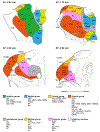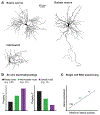Thalamic subnetworks as units of function
- PMID: 35102334
- PMCID: PMC9400132
- DOI: 10.1038/s41593-021-00996-1
Thalamic subnetworks as units of function
Abstract
The thalamus engages in various functions including sensory processing, attention, decision making and memory. Classically, this diversity of function has been attributed to the nuclear organization of the thalamus, with each nucleus performing a well-defined function. Here, we highlight recent studies that used state-of-the-art expression profiling, which have revealed gene expression gradients at the single-cell level within and across thalamic nuclei. These gradients, combined with anatomical tracing and physiological analyses, point to previously unappreciated heterogeneity and redefine thalamic units of function on the basis of unique input-output connectivity patterns and gene expression. We propose that thalamic subnetworks, defined by the intersection of genetics, connectivity and computation, provide a more appropriate level of functional description; this notion is supported by behavioral phenotypes resulting from appropriately tailored perturbations. We provide several examples of thalamic subnetworks and suggest how this new perspective may both propel progress in basic neuroscience and reveal unique targets with therapeutic potential.
© 2022. Springer Nature America, Inc.
Conflict of interest statement
Competing interests
The authors declare no competing interests, financial or otherwise.
Figures







References
-
- Jones EG The Thalamus (New York: Plenum Press, 1985).
-
- Sherman SM & Guillery RW Exploring the thalamus and its role in cortical function (MIT Press, 2006).
-
- Jones EG The Thalamus (Cambridge Univ. Press, 2007).
-
- Hubel DH & Wiesel TN Early exploration of the visual cortex. Neuron 20, 401–412 (1998). - PubMed
Publication types
MeSH terms
Grants and funding
LinkOut - more resources
Full Text Sources

